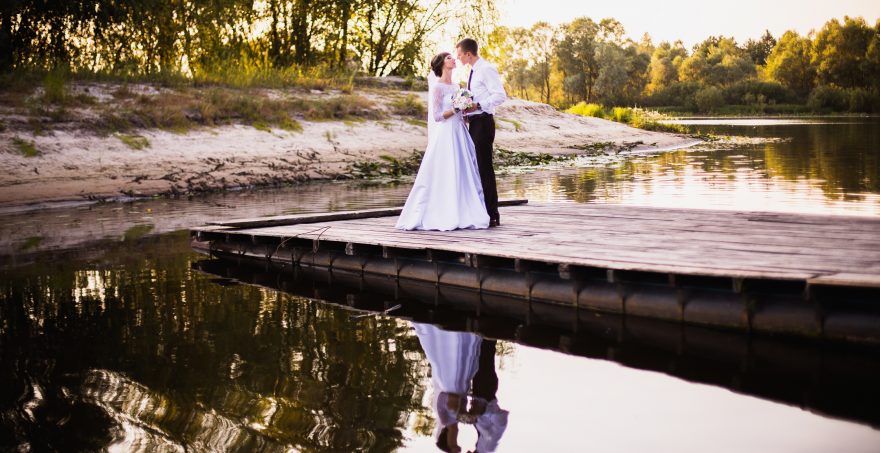The Order of Celebrating Matrimony Between a Catholic and a Catechumen or a Non-Christian

“In their preparation for marriage, the couple should be encouraged to make the liturgical celebration a profound personal experience and to appreciate the meaning of each of its signs.”
– Pope Francis, Amoris Laetitia, no. 213
When a Catholic marries an unbaptized person or a person preparing for baptism (a catechumen), the following form of the wedding ceremony is used. While the marriage will not be a sacrament (since that requires both bride and groom to be baptized), it will be a valid Catholic marriage as long as the couple has received permission from the local bishop. The celebration can take place in a church or in another suitable place; this is something the couple should discuss with the Catholic’s parish priest.
The Order for Celebrating Matrimony between a Catholic and a Catechumen or a Non-Christian takes place outside Mass. The ceremony offers a wide range of options so that the couple, with the assistance of the priest or deacon, can tailor it to their circumstances. For example, the Liturgy of the Word can take place in the usual manner with readings like those for a wedding Mass, but the couple could also choose to reduce the Liturgy of the Word to a single Scripture reading. What may never be omitted or changed, however, is the consent exchanged between the bride and groom. This is the “indispensable element that ‘makes the marriage’” (Catechism of the Catholic Church, no. 1626).
The structure of the ceremony for a wedding between a Catholic and a catechumen or non-Christian is outlined below, with various options in parentheses. Engaged couples are encouraged to work together with the celebrant (and perhaps the parish staff) to make their choices for certain texts of the wedding, such as the Scripture readings, the Prayers of the Faithful, and the musical selections. This will help make the wedding liturgy “a profound personal experience” of “full, active and responsible participation” by the bride and groom (Pope Francis, Amoris Laetitia, no. 213; St. John Paul II, Familiaris Consortio, no. 67).
Engaged couples in interfaith relationships (a Catholic and an unbaptized non-Catholic) may be interested in reading this article: Ecumenical and Interfaith Marriages.
A general outline for a Latin Rite Catholic wedding between a Catholic and a catechumen or non-Christian follows, based on the new edition of the Order of Celebrating Matrimony (mandatory to use in the United States as of December 30, 2016). Because there are many options to choose from and various circumstances that can affect the planning of a wedding ceremony, it is very important to work with the priest or deacon in arranging the service. Certain details might differ from what is outlined below.
The Rite of Reception
“The marriage liturgy is a unique event, which is both a family and a community celebration. The first signs of Jesus were performed at the wedding feast of Cana. The good wine, resulting from the Lord’s miracle that brought joy to the beginning of a new family, is the new wine of Christ’s covenant with the men and women of every age.” – Pope Francis, Amoris Laetitia, no. 216
Note: The Rite of Reception may be omitted entirely.
- Welcome of the bride and bridegroom by the celebrant and procession into the place of the wedding
- Greeting of the couple and congregation, and introduction of the Liturgy of the Word
The Liturgy of the Word
“The couple can also meditate on the biblical readings…and the other signs that are part of the rite.” – Pope Francis, Amoris Laetitia, no. 216
- There may be one or two readings; at least one reading must make explicit reference to marriage (various options here: Old Testament, New Testament, Gospel)
- Homily based on the Scriptures, Church teaching on marriage, and the individual couple
The Celebration of Matrimony
“It needs to be stressed that these words [of consent] cannot be reduced to the present; they involve a totality that includes the future: ‘until death do us part.’” – Pope Francis, Amoris Laetitia, no. 214
“The consent by which the spouses mutually give and receive one another is sealed by God himself.” – Catechism of the Catholic Church, no. 1639
- Address to the couple by the priest or deacon
- The Questions before the Consent
- The Consent(two versions of the vows to choose from, and the couple can either say the words themselves or respond “I do” to the vows posed as a question by the priest or deacon)
- The Reception of the Consent by the priest or deacon
- The Blessing and Giving of Rings (three versions to choose from; may be omitted if circumstances suggest)
- Optional: The Blessing and Giving of the Arras, a tradition important in Hispanic and Filipino families
- Optional: a hymn or canticle of praise may be sung
- The Universal Prayer / Prayers of the Faithful (two examples provided in the liturgical text; couples can also work with the celebrant to write their own)
- The Lord’s Prayer
- Optional: The Blessing and Placing of the Lazo or the Veil, a tradition important in Hispanic and Filipino families
- The Nuptial Blessing (may be replaced with another shorter prayer if circumstances suggest)
- Final Blessing
Note: after the ceremony, the witnesses (usually the best man and maid of honor) and priest or deacon sign the Marriage record in the vesting room or in the presence of the people, but not on the altar.




